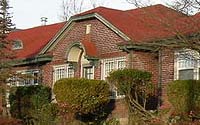HOME ENERGY
How to become a home electricity generator and control your energy costs.
Our energy landscape is changing. Energy prices reached record highs this year, contributing to economic and political uncertainty. The UK currently imports the equivalent of 60% of its energy needs, making us vulnerable to international events beyond our control. Homegrown renewable energy has the potential to deliver long-term energy security. Generating energy at home gives consumers greater control over their costs and what they use.
Many households have already taken steps to secure their energy future by installing their own renewable electricity generation system and taking advantage of the Government Feed-in Tariff. Introduced in April 2010, the Feed-in Tariff is designed to encourage small-scale renewable electricity generation by making payments to individuals, businesses and communities for every unit of electricity they generate. The scheme makes further payments for electricity exported to the grid. Payments are index-linked, tax-free and guaranteed for up to 25 years.
Recently, renewable energy company Good Energy published a report highlighting how the Feed-in Tariff has led to a dramatic increase in the number of home generators across the UK. The report presents the findings of a nationwide survey of Good Energy renewable electricity generation customers that are claiming the Feed-in Tariff.
Becoming a home generator is easier and more affordable than ever before. So how do you get started? Good Energy suggests the following five steps:
1. Select the right technology and the right location
You need to consider which renewable energy technology is best suited to your home. Take the time to understand some of the basic technical requirements. Good Energy offers a free online assessment survey at goodenergy.co.uk/pvsurvey.
2. Find out about planning
Before starting any renewable energy project, look into local and national planning
regulations. Consult your local council’s website for any conditions. Many microgeneration projects are classed as ‘permitted development rights’, meaning permission to install is automatically granted provided particular conditions are met.
3. Choose the right installer
Ask installers for references and examples of recent installations in your area. Make sure they are accredited by the Microgeneration Certification Scheme and Renewable Energy Association. Obtain three written quotations before making a decision. Quotes should include performance estimates tailored to your property and a list of what the installer will provide.
4. Decide on finance
There are several finance options depending on your circumstances. You could apply for a personal loan and use income from the Feed-in Tariff for repayments. Remortgaging is another possibility. Alternatively, if you don’t have the money to purchase your own system, ‘Solar PV for Free’ schemes will install solar panels free of charge in exchange for the homeowner’s Feed-in Tariff payments.
Terms and conditions vary among installers and it is important to know that these schemes require the homeowner to enter into a lease agreement with the installer, which can last for up to 25 years.
5. Choose a reliable FIT licensee
Compare a number of FIT licensees to find the one that best suits you and your circumstances. You don’t have to register for FIT with your existing electricity supplier.
Generating you own renewable electricity is the only way to secure your energy future. It will reduce you electricity bill and provide you with another source of income. Switching to renewable energy can make a genuine difference to climate change and bring us closer to the UK’s carbon emissions reduction target.
You can see the full Good Energy FIT Report at: http://bit.ly/srX4n6.

